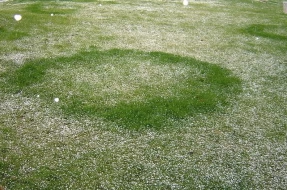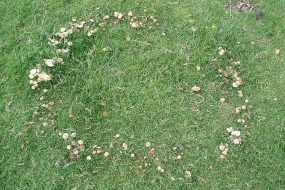Pathogen Profile: Fairy Ring in Florida Turfgrass
- David Santos, MBiotech
- Mar 20, 2024
- 5 min read
Updated: May 6, 2024
“The unpredictable nature of Fairy Ring and its destructive impact on turfgrass frustrate even the best golf course superintendents.” - Golf Course Superintendents Association of America.
by Jessica O'Hanlon, BSc and David Santos MBiotech
Most Florida residents are familiar with the circular formations of mushrooms that pop up instantaneously overnight, especially golf course superintendents. Fairy Ring is a common turfgrass problem caused by over 60 different species of fungi, including Chlorophyllum spp., Marasmius spp., Lepiota spp., Lycoperdon spp., and other basidiomycete fungi. Fairy Ring affects multiple turfgrass species, including Bermuda grass–a common turfgrass used in Florida golf courses.
The unique symptoms, circular or semi-circular patterns, make it easily recognizable on turf and golf grass surfaces. The economic impact of Fairy Ring is significant, leading to aesthetic and functional damage to turfgrass and requiring costly treatments and maintenance efforts. Considering Florida has over 1,200 golf courses contributing to the total 4 million acres of managed turfgrass, Fairy Ring becomes a critical pest to mitigate. In this guide, we'll discuss the symptoms, life cycle, growth conditions, and prevention and control methods of Fairy Ring to help turf and golf grass growers maintain healthy, attractive lawns.
Table of Hosts:
Grass Type | Susceptibility to Fairy Ring |
Bentgrass | High |
Bermuda | Medium |
Bluegrass | High |
Fescue | Medium |
Ryegrass | Medium |
St. Augustine | Low |
Zoysiagrass | Low |
Table 1: Common turfgrasses and their susceptibility to Fairy Ring rated from Low, Medium and High.
Symptoms:
The characteristic symptom of Fairy Ring is the appearance of rings or arcs of dark green, fast-growing grass. The affected areas may vary in size from a few inches to several feet in diameter. In some cases, mushrooms or puffballs may appear along the ring's edge. The fungi responsible for edaphic (soil-related) fairy rings have the ability to extend the growth of their mycelium deep into the soil profile, reaching a depth of 2 to 3 feet. Most Fairy Ring fungi do not directly infect or parasitize the turfgrass. Instead, their growth in the soil can indirectly affect the turfgrass above, potentially causing damage or even death through methods such as competing for nutrients.
Symptoms can vary depending on the species of fungi involved and environmental conditions, including:
Thinning or dying grass
Hydrophobic soil (water-repellent)
Unpleasant odor from decaying organic matter
To See En-Turf in action and current research on microbials, see the report here:
Types of Fairy Ring
Visual Differences of the Three Types of Fairy Ring:
Three types of Fairy Ring (from left to right): Type 1 dead spots, Type 2 lush green circle, and Type 3 fungal ring. https://hort.extension.wisc.edu/articles/fairy-rings/
There are three types of Fairy ring descriptions, each with distinct symptoms:
Type | Characteristics | Properties of soil | Effect on turfgrass |
1 | Dead or necrotic rings of grass, often surrounded by an inner or outer ring of dark green grass | Grows vigorously due to nitrogen release | Generates substances that hinder the grass's ability to absorb moisture from the soil, resulting in dehydration. Most severe type. |
2 | Dark, lush rings of grass, which may or may not have fruiting bodies | Hydrophobic soil conditions and/or localized dry spots | Accelerates the decomposition of organic matter, expediting its conversion into nitrogen, which promotes the growth of dense and luxuriant grass. |
3 | Rings of mushrooms, puffballs, or other fungal structures (basidiocarps), no visible impact on the growth of turfgrass | Wet regions, abundant organic matter, more common in the fall | Formation of circular mushrooms in the yard. The moist conditions may arise from excessive rainfall or inadequate drainage. |
Table 2: The three types of fairy ring are described by their characteristics, properties of soil and effect on turfgrass.
Life Cycle and Infection Stages:
The life cycle of Fairy Ring fungi begins when fungal spores germinate in the soil. The fungi break down organic matter, releasing nutrients that promote grass growth and forming visible rings. The fungus spreads outward as it consumes available organic material, and the infection advances in a radial pattern. Over time, the rings may expand, merge, or disappear as the fungi exhaust their food sources and if left untreated, the fungi can live for decades.
Once the food supply diminishes, the fungus initiates radial growth in all directions (as depicted by the red line), in search of sustenance. The center of the expanding fairy ring (indicated by the brownish circle in the diagram) experiences plant death due to the hydrophobic soil created by the fungus. The fungus decomposes organic matter resulting in the growth of dense and dark green turf (stimulated zone in the diagram). Photo source: https://www.ctahr.hawaii.edu/oc/freepubs/pdf/PD-49.pdf
Growth Conditions:
While Fairy Ring can affect many different types of turfgrass any time of year, Florida golf courses are especially prone to outbreaks due to climate and soil properties. The prevalence of sand soils makes it difficult for turfgrass to retain moisture. Fairy ring is most aggressive on golf course greens in the summer when Florida receives most of its rainfall. The first sightings of Fairy Ring typically occur after 2-3 days of heavy rainfall, followed by sunny, dry days. In addition, Type 3 is frequently noticed on recently established or renovated Bermuda grass greens within a year following sprigging.
Fairy Ring fungi thrive in the following conditions:
High organic matter content in the soil
Compacted soil
Poorly drained areas
Dry, warm weather
Thatch buildup
In the turf sample above, the Fairy Ring fungus has colonized the soil layers. The build up of the thatch layer and the sandy soil have led to the ability of the fungus to grow in the turfgrass. Photo source: https://content.ces.ncsu.edu/fairy-ring-in-turf
Methods of Prevention and Control:
Controlling Fairy Ring can not only be expensive and tiresome, but extremely important for the turfgrass's health and the surrounding community. In 2019 in Florida, a dog ate a poisonous Fairy Ring mushroom, resulting in death. Preventing the establishment of Fairy Ring is the most effective approach for its control. Implementing cultural and chemical practices can help prevent and control Fairy Ring:
Aeration: Regular aeration of the soil can alleviate compaction, enhance water infiltration, and disrupt the growth of fungi. However, aeration has also been shown to cause an increase in stress in the grass, which has been linked to Fairy Ring outbreaks.
Biostimulants: Biostimulants help prevent Fairy Ring by improving turfgrass health, promoting root development, nutrient uptake, stress tolerance, and balancing the soil microbiome. Due to the sandy soils in Florida, biostimulants can provide a multifaceted approach to mitigation. By enhancing overall plant vigor and resilience, biostimulants reduce the susceptibility of turfgrass to Fairy Ring. As research on biostimulants advances, they are proving to be an effective alternative to the lack of reliable chemical products.
Irrigation: Ensure proper irrigation to prevent stress caused in times of drought and excess water. Fairy Rings can cause soil to become hydrophilic, which makes watering much more difficult.
Thatch Management: Regular dethatching helps to reduce the organic matter that fuels Fairy Ring growth.
Fertilization: Maintaining balanced fertility promotes healthy turfgrass and reduces the contrast between affected and unaffected areas.
Chemical Control: Fungicides may be applied to the affected areas, but their effectiveness may vary depending on the specific species of fungi present.
Conclusion:
Fairy Ring is a common and challenging issue faced by golf course superintendents, especially in Florida, due to the climate, soil properties, and abundance of managed turfgrass. By understanding its symptoms, life cycle, and growth conditions and employing proper prevention and control methods, you can minimize its impact on your turfgrass and maintain a healthy, attractive, and playable surface.
If you are interested in talking more about En-Turf and how it fortifies plants against stressors, you can connect with us here:
References:
Downer, A.J., and M.A. Harivandi. “Fairy Ring.” UC Statewide IPM Program (UC IPM), ipm.ucanr.edu/agriculture/turfgrass/fairy-ring/#:~:text=Fairy%20ring%20can%20be%20eliminated,raked%20off%20and%20disposed%20of.
Fidanza, Mike. “Dr. Basidiomycetes or: How I Learned to Stop Fairy Ring.” Golfdom, 16 May 2023, www.golfdom.com/dr-basidiomycetes-or-how-i-learned-to-stop-fairy-ring/.
Fidanza, Michael, et al. “Fairy Ring Biology and Management in Turfgrass .” Turf Diseases, Turfgrass Trends, Apr. 2000, pp. 6–10.
“Florida Dog Dies after Eating Poisonous ‘Fairy Ring’ Mushroom, Owner Says.” FOX 51, 11 Dec. 2019, www.wogx.com/news/florida-dog-dies-after-eating-poisonous-fairy-ring-mushroom-owner-says.
Kammerer, Steve. “Fairy Ring on Greens Is No Fun.” USGA, www.usga.org/content/usga/home-page/course-care/green-section-record/59/16/fairy-ring-on-greens-is-no-fun.html.
Phillips, Hal. “The Distributor and the Category-Buster: A Fairy Ring Tale.” Golf Course Industry, 6 Oct. 2020, www.golfcourseindustry.com/news/fairy-ring-mike-bailey-monterey-ycc-matt-lean-miami-dolphins-ed-lamour/.
Research - Florida Turfgrass Association, www.ftga.org/page/Research.
An older version of this blog can be found at: https://www.earthmicrobial.com/blogs/golf/pathogen-profile-fairy-florida-turfgrass





